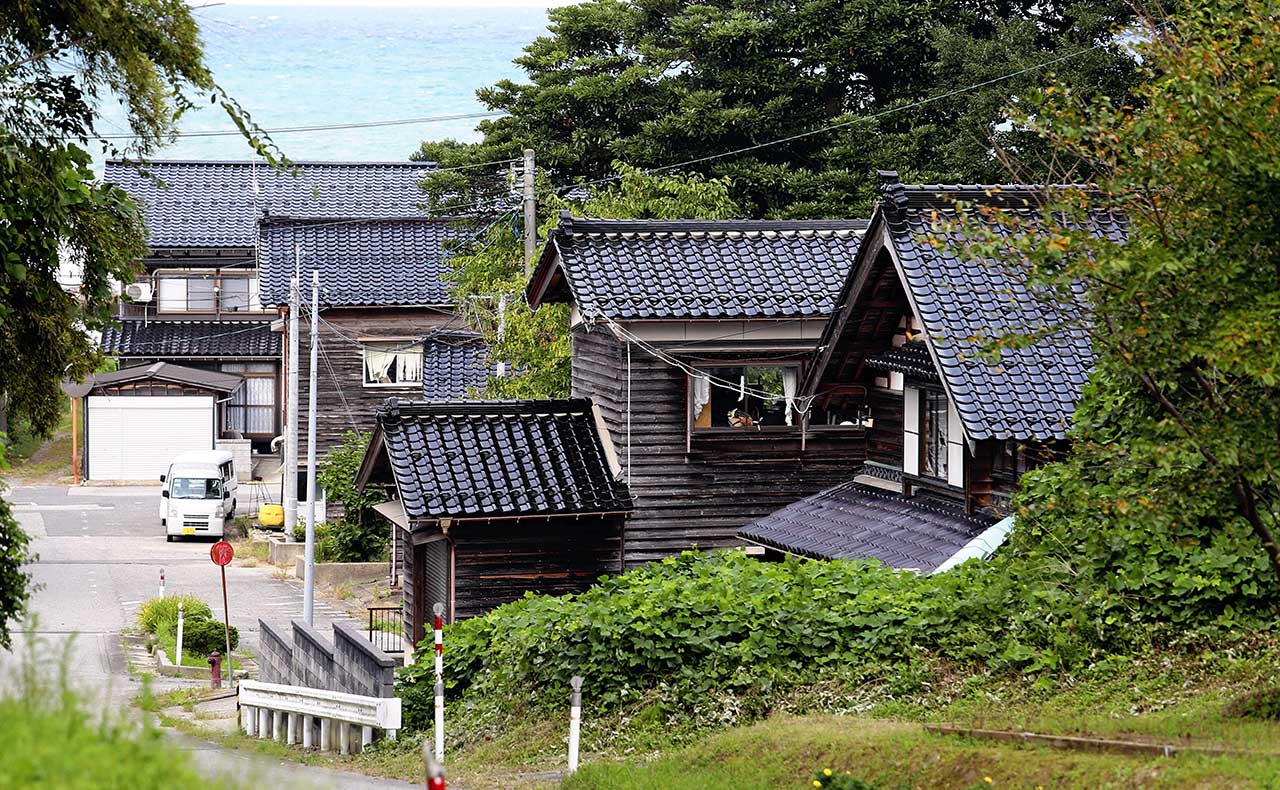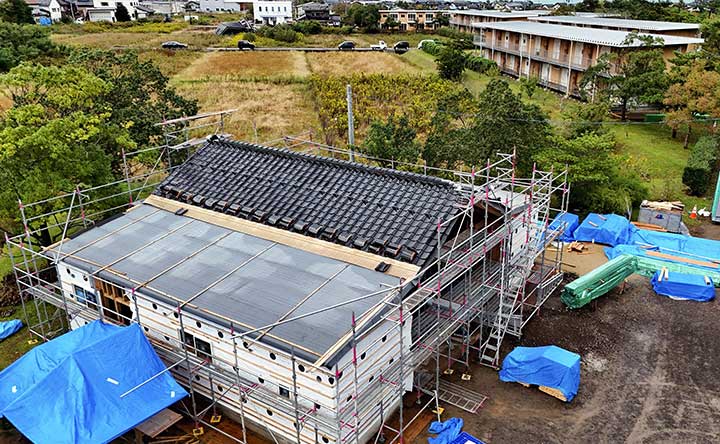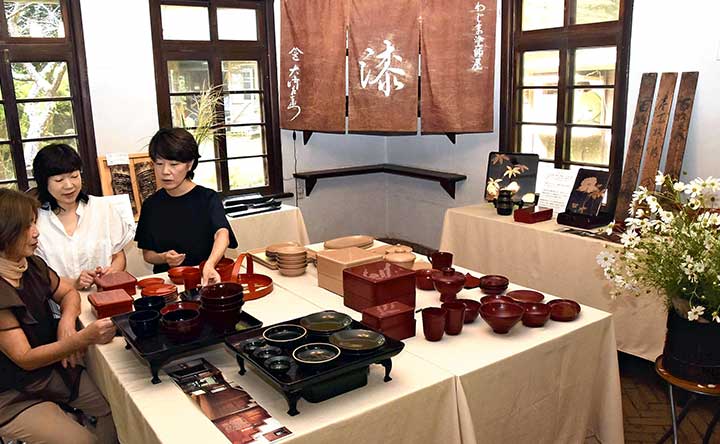Thu, Nov 28, 2024

The Noto Peninsula in northern Ishikawa Prefecture was devastated this year (2024) by a major earthquake on New Year’s Day, and then by record rains causing floods and landslides in late September. The residents of the area are making great efforts to get back on their feet and recover from the relentless disasters. Some of them, along with supporters who have expert knowledge in history, architecture and other fields, have stood up to help restore and preserve the region’s cultural heritage.
A great number of the region’s traditional homes with Noto-gawara roof tiles were destroyed in the New Year’s Day earthquake, while modern homes built with metal roofing satisfying current quake-resistance standards withstood the shock. Some residents were quick to blame the heavy Noto-gawara for the state of the traditional homes.

However, Shigeru Ban, 67, a Pritzker Prize-winning architect well known for his disaster relief activities, says otherwise: “Traditional homes in Noto sometimes leave out some of the cross bracings to make the rooms more spacious. Structural strength calculations may have gone wrong because of this. It is not the fault of Noto-gawara.” He is concerned that if publicly funded demolition of quake-damaged houses proceed as is, “The townscape of Oku-Noto (northern area of Noto Peninsula) will end up looking like a nondescript industrial product.”


In June, the Voluntary Architects’ Network (VAN), a non-profit organization led by Ban, in cooperation with the city of Suzu, kawara (roof tile) layers and demolition contractors, started gathering Noto-gawara from damaged homes that were getting demolished about twice every month. At the end of September, members of the NPO and student volunteers from the Shibaura Institute of Technology based in Tokyo worked arduously to collect Noto-gawara — which weighs about three kilograms a piece — at the Honju-ji temple in Suzu. They intend to gather about 10,000 kawara in total by late October and re-use them to construct a meeting hall near the Mitsukejima rock island, a city landmark.
The prefectural government of Ishikawa has set a goal to demolish more than 32,000 damaged buildings by October 2025. As of mid-October 2024, they have achieved about 18 percent of their goal. Demolition debris is estimated to reach 3.32 million tons.
According to the municipal government of Suzu, the kawara industry in the area had started to develop during the Meiji era (1868-1912). Later, due to a boom in housing construction during Japan’s period of high economic growth (1950s-70s), the local production volume grew to about five to six million kawara. However, about 30 years ago, the last kawara factory in the city stopped producing Noto-gawara altogether, leaving no manufacturers behind in the entire prefecture.
The Culture Council of the Agency for Cultural Affairs recommended on Oct. 18, 2024, that the Soto school temple Soji-ji Soin in Wajima, another city in Ishikawa Prefecture, should be designated as an important cultural property of Japan. People involved hope that the temple will serve as a “symbol of reconstruction” in the quake-and-rain-stricken area of Noto.
Fallen stone lanterns and building walls coming off are still conspicuous on the premises of the temple. A part of a corridor that serves as a channel connecting multiple temple buildings had collapsed and is covered with blue tarps.

Soji-ji Soin, a branch of the Soji-ji in Yokohama (one of the two head temples of Soto Zen Buddhism in Japan), was established in 1321. A part of its premises remains inaccessible after the New Year’s Day earthquake, but local residents continue to visit the temple to offer their prayers.
After the Noto earthquake, local government officials and cultural property experts in the universities and museums in Ishikawa have established an intra-prefectural network to engage in “cultural heritage rescue” activities to conserve precious historical resources including ancient documents, diagrams and photos.

Some 20 experts of the network got together at the Ishikawa Prefectural Museum of History in the prefectural capital of Kanazawa on Oct. 20, 2024, to sort out the damaged historical resources. A number of old documents from Japan’s pre-modern and modern times passed down in an old family of Suzu were layed out over the table. The documents, mostly regarding land, finance and the local fishing industry among others, included a diagram of the fisheries of the time. Going through the papers are essential in unveiling the history of the industry in Noto.
Although a number of old homes in Suzu were inevitably demolished, a few thousand documents and the like were moved to safe locations by their owners, and are now kept in the museum. For future use in historical researches, the documents are being sorted out by the experts.

History majors at Kanazawa University and Kanazawa Gakuin University are participating in the sorting out process. “It is a valuable opportunity for the students to be able to handle actual documents,” Kanazawa Gakuin Univ. Professor Toshihiko Honda, who specializes in Japan’s medieval and pre-modern history and heads the network, said. “Many of them are joining in to do something for Noto.”
Members of the network go to various parts of Noto and continue their efforts, working in tandem with the Cultural Heritage Disaster Risk Management Center, a specialized agency of the Japanese government, to “rescue” disaster-affected cultural assets. In disaster-stricken areas, historical resources are often buried under collapsed buildings, or left behind in storehouses and cellars.
Famed actor Tatsuya Nakadai, 91, who leads the Mumei-juku (School of the nameless) acting troupe, is said to have loved the ambience. This led to the foundation of the Noto Engekido Theater in Nanao, Ishikawa Pref., in 1995. The theater, dedicated to stage performances and supervised by Nakadai himself, has since then served as the city’s landmark.

The theater, too, took damages from the earthquake. The stage mechanisms that control the stage lights and other gadgetry went out of order, and the parking lot was affected. The following day, onn Jan. 2, the stage lights were found hanging down from the ceiling, and stage weight (10 kilograms ea.) were scattered over the stage floor. The bolt of the sliding back wall of the stage was bent.
Repair work of the stage was completed in October 2024, but the safety inspection of the ceiling over the audience seats continue.
Museums and cultural facilities that speak of Noto’s history and nature are also among the buildings damaged by the earthquake.

The Mawaki Site is one of the largest archaeological sites showcasing the remains of a Jomon period settlement in the Hokuriku region surrounding the peninsula. Some of the ancient earthenware kept in the repository of the museum of Jomon archaeology on the site were broken in the earthquake, and a part of the road leading to the museum collapsed after the torrential rains in September.
Somehow, a Jomon cabin reconstructed based on findings from excavation at the site withstood the shock.
Nushiya, producers and vendors of Wajima-nuri lacquerware, were also profoundly affected by the New Year’s Day earthquake.
The Osaki Lacquerware Shop in Wajima, Ishikawa Pref., a traditional home of a nushiya registered as a tangible cultural property of Japan (Registered name: Osaki Family Residence Main House), was completely destroyed. In hopes of a quick recovery, fans and customers of the shop are busying about selling the shop’s merchandise.

On October 19, 2024, lacquerware of different shapes and color from the Osaki Lacquerware Shop were put on display at an atelier-turned old folk home in faraway Kitakamakura (an area near Kamakura in Kanagawa Prefecture). The shop’s merchandise was being sold by a group of fans who got together after the earthquake in support of the shop.
(From The Yomiuri Shimbun and other sources)
0%